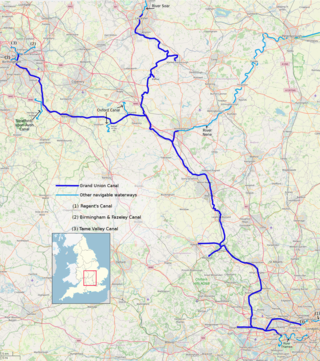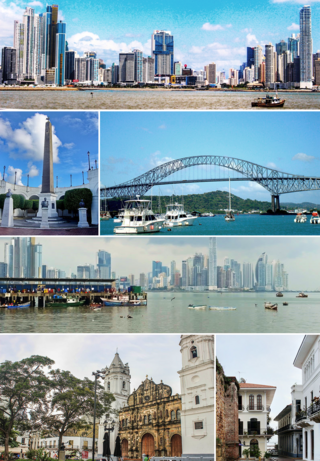The topic of this article may not meet Wikipedia's general notability guideline .(April 2024) |
In anatomy, a canal (or canalis in Latin) is a tubular passage or channel which connects different regions of the body.
The topic of this article may not meet Wikipedia's general notability guideline .(April 2024) |
In anatomy, a canal (or canalis in Latin) is a tubular passage or channel which connects different regions of the body.

Barge often refers to a flat-bottomed inland waterway vessel which does not have its own means of mechanical propulsion. The first modern barges were pulled by tugs, but on inland waterways, most are pushed by pusher boats, or other vessels. The term barge has a rich history, and therefore there are many other types of barges.

Canals or artificial waterways are waterways or engineered channels built for drainage management or for conveyancing water transport vehicles. They carry free, calm surface flow under atmospheric pressure, and can be thought of as artificial rivers.

The Erie Canal is a historic canal in upstate New York that runs east–west between the Hudson River and Lake Erie. Completed in 1825, the canal was the first navigable waterway connecting the Atlantic Ocean to the Great Lakes, vastly reducing the costs of transporting people and goods across the Appalachians. In effect, the canal accelerated the settlement of the Great Lakes region, the westward expansion of the United States, and the economic ascendancy of New York State. It has been called "The Nation's First Superhighway."

The Panama Canal is an artificial 82-kilometre (51-mile) waterway in Panama that connects the Atlantic Ocean with the Pacific Ocean, cutting across the Isthmus of Panama, and is a conduit for maritime trade. Locks at each end lift ships up to Gatun Lake, an artificial fresh water lake 26 meters (85 ft) above sea level, created by damming up the Chagres River and Lake Alajuela to reduce the amount of excavation work required for the canal. Locks then lower the ships at the other end. An average of 200,000,000 L (52,000,000 US gal) of fresh water is used in a single passing of a ship. The canal is threatened by low water levels during droughts.

The Sinai Peninsula, or simply Sinai, is a peninsula in Egypt, and the only part of the country located in Asia. It is between the Mediterranean Sea to the north and the Red Sea to the south, and is a land bridge between Asia and Africa. Sinai has a land area of about 60,000 km2 (23,000 sq mi) and a population of approximately 600,000 people. Administratively, the vast majority of the area of the Sinai Peninsula is divided into two governorates: the South Sinai Governorate and the North Sinai Governorate. Three other governorates span the Suez Canal, crossing into African Egypt: Suez Governorate on the southern end of the Suez Canal, Ismailia Governorate in the center, and Port Said Governorate in the north.

The Suez Canal is an artificial sea-level waterway in Egypt, connecting the Mediterranean Sea to the Red Sea through the Isthmus of Suez and dividing Africa and Asia. The 193.30-kilometre-long (120.11 mi) canal is a key trade route between Europe and Asia.

The Grand Union Canal in England is part of the British canal system. It is the principal navigable waterway between London and the Midlands. Starting in London, one arm runs to Leicester and another ends in Birmingham, with the latter stretching for 137 miles (220 km) with 166 locks from London. The Birmingham line has a number of short branches to places including Slough, Aylesbury, Wendover, and Northampton. The Leicester line has two short arms of its own, to Market Harborough and Welford.

The Grand Canal is the longest canal or artificial river in the world and a UNESCO World Heritage Site. Its main artery, known to the Chinese as the Jing–Hang or Beijing–Hangzhou Grand Canal, is reckoned to extend for 1,776 km (1,104 mi) and is divided into 6 main sections. The Jiangnan Canal runs from the Qiantang River at Hangzhou to the Yangtze River at Zhenjiang; the Inner Canal from the Yangtze at Yangzhou to the Huai River at Huai'an, which for centuries was also its junction with the former course of the Yellow River; the Middle Canal from Huai'an to the Nansi Lakes; the Lu Canal from the lakes past Jining and the present course of the Yellow River to the Wei River at Linqing; the Southern Canal from Linqing to the Hai River at Tianjin; and the Northern Canal from Tianjin to Tongzhou on the outskirts of Beijing. As such, it passes through the provinces and municipalities of Zhejiang, Jiangsu, Shandong, Hebei, Tianjin, and Beijing. In 2014, the Chinese government and UNESCO recognized the Eastern Zhejiang Canal from Hangzhou to Ningbo along the former Tongji and Yongji Canals as official components of the Grand Canal.

Panama City, also known as Panama, is the capital and largest city of Panama. It has a total population of 1,086,990, with over 1,500,000 in its urban area. The city is located at the Pacific entrance of the Panama Canal, in the province of Panama. The city is the political and administrative center of the country, as well as a hub for banking and commerce.

The Suez Crisis or the Second Arab–Israeli War, also referred to as the Tripartite Aggression in the Arab world and as the Sinai War in Israel, was a British–French–Israeli invasion of Egypt in 1956. Israel invaded on 29 October, having done so with the primary objective of re-opening the Straits of Tiran and the Gulf of Aqaba as the recent tightening of the eight-year-long Egyptian blockade further prevented Israeli passage. After issuing a joint ultimatum for a ceasefire, the United Kingdom and France joined the Israelis on 5 November, seeking to depose Egyptian president Gamal Abdel Nasser and regain control of the Suez Canal, which Nasser had earlier nationalised by transferring administrative control from the foreign-owned Suez Canal Company to Egypt's new government-owned Suez Canal Authority. Shortly after the invasion began, the three countries came under heavy political pressure from both the United States and the Soviet Union, as well as from the United Nations, eventually prompting their withdrawal from Egypt. Israel's four-month-long occupation of the Egyptian-occupied Gaza Strip and Egypt's Sinai Peninsula enabled it to attain freedom of navigation through the Straits of Tiran, but the Suez Canal itself was closed from October 1956 to March 1957. The Suez Crisis led to international humiliation for the British and the French in the wake of the Cold War, which established the Americans and the Soviets as the world's superpowers. It also strengthened Nasser's standing.

British Waterways, often shortened to BW, was a statutory corporation wholly owned by the government of the United Kingdom. It served as the navigation authority for the majority of canals and a number of rivers and docks in England, Scotland and Wales.

The Leeds and Liverpool Canal is a canal in Northern England, linking the cities of Leeds and Liverpool.

A lock is a device used for raising and lowering boats, ships and other watercraft between stretches of water of different levels on river and canal waterways. The distinguishing feature of a lock is a fixed chamber in which the water level can be varied; whereas in a caisson lock, a boat lift, or on a canal inclined plane, it is the chamber itself that rises and falls.

The Manchester Ship Canal is a 36 mi-long (58 km) inland waterway in the North West of England linking Manchester to the Irish Sea. Starting at the Mersey Estuary at Eastham, near Ellesmere Port, Cheshire, it generally follows the original routes of the rivers Mersey and Irwell through the historic counties of Cheshire and Lancashire. Several sets of locks lift vessels about 60 ft (18 m) to the canal's terminus in Manchester. Landmarks along its route include the Barton Swing Aqueduct, the world's only swing aqueduct, and Trafford Park, the world's first planned industrial estate and still the largest in Europe.

The Rideau Canal is a 202 kilometre long canal that links the Ottawa River at Ottawa with the Cataraqui River and Lake Ontario at Kingston, Ontario, Canada. Its 46 locks raise boats from the Ottawa River 83 metres upstream along the Rideau River to the Rideau Lakes, and from there drop 50 metres downstream along the Cataraqui River to Kingston.

The Panama Canal Zone, also simply known as the Canal Zone, was a concession of the United States located in the Isthmus of Panama that existed from 1903 to 1979. It consisted of the Panama Canal and an area generally extending five miles (8 km) on each side of the centerline, but excluding Panama City and Colón. Its capital was Balboa.

The Intracoastal Waterway (ICW) is a 3,000-mile (4,800 km) inland waterway along the Atlantic and Gulf of Mexico coasts of the United States, running from Massachusetts southward along the Atlantic Seaboard and around the southern tip of Florida, then following the Gulf Coast to Brownsville, Texas. Some sections of the waterway consist of natural inlets, saltwater rivers, bays, and sounds, while others are artificial canals. It provides a navigable route along its length without many of the hazards of travel on the open sea.
Canal+ is a French premium television channel launched in 1984. It is owned by the Groupe Canal+. The channel broadcasts several kinds of programming, mostly encrypted. Unencrypted programming can be viewed free of charge on Canal+ and on satellite on Canal+ Clair. The channel does not broadcast advertising, except when broadcasting on free-to-air slots. Almost all foreign films and series can be viewed either in their original language with French subtitles or dubbed in French. All programs are subtitled in French for deaf people and those who struggle with hearing. Some programs also have audio description for those who are visually impaired.
StudioCanal S.A.S. is a French film production and distribution company that owns the third-largest film library in the world. The company is a unit of the Canal+ Group, owned by Vivendi.

Canal+ Group is a French media and telecommunications conglomerate. It is owned and controlled by Vivendi and has a film library in excess of 5,000 films. It is headquartered in Issy-les-Moulineaux, in the suburbs of Paris. It has operations in France, the Netherlands, Belgium, Austria, Poland, Romania, Hungary, in the Czech Republic, Myanmar, Vietnam, and in 23 African countries.